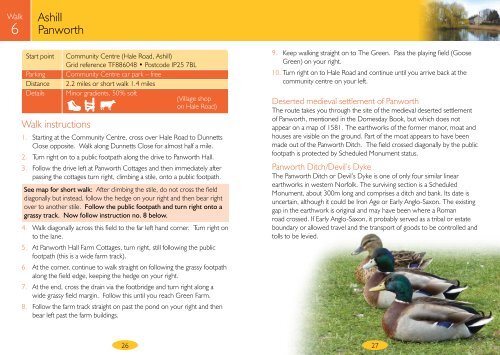Norfolk health, heritage and biodiversity walks - Enjoying the Norfolk ...
Norfolk health, heritage and biodiversity walks - Enjoying the Norfolk ...
Norfolk health, heritage and biodiversity walks - Enjoying the Norfolk ...
You also want an ePaper? Increase the reach of your titles
YUMPU automatically turns print PDFs into web optimized ePapers that Google loves.
Walk<br />
6<br />
Ashill<br />
Panworth<br />
Start point Community Centre (Hale Road, Ashill)<br />
Grid reference TF886048 • Postcode IP25 7BL<br />
Parking Community Centre car park – free<br />
Distance 2.2 miles or short walk 1.4 miles<br />
Details Minor gradients, 50% soft<br />
Walk instructions<br />
1. Starting at <strong>the</strong> Community Centre, cross over Hale Road to Dunnetts<br />
Close opposite. Walk along Dunnetts Close for almost half a mile.<br />
2. Turn right on to a public footpath along <strong>the</strong> drive to Panworth Hall.<br />
3. Follow <strong>the</strong> drive left at Panworth Cottages <strong>and</strong> <strong>the</strong>n immediately after<br />
passing <strong>the</strong> cottages turn right, climbing a stile, onto a public footpath.<br />
See map for short walk: After climbing <strong>the</strong> stile, do not cross <strong>the</strong> field<br />
diagonally but instead, follow <strong>the</strong> hedge on your right <strong>and</strong> <strong>the</strong>n bear right<br />
over to ano<strong>the</strong>r stile. Follow <strong>the</strong> public footpath <strong>and</strong> turn right onto a<br />
grassy track. Now follow instruction no. 8 below.<br />
4. Walk diagonally across this field to <strong>the</strong> far left h<strong>and</strong> corner. Turn right on<br />
to <strong>the</strong> lane.<br />
5. At Panworth Hall Farm Cottages, turn right, still following <strong>the</strong> public<br />
footpath (this is a wide farm track).<br />
6. At <strong>the</strong> corner, continue to walk straight on following <strong>the</strong> grassy footpath<br />
along <strong>the</strong> field edge, keeping <strong>the</strong> hedge on your right.<br />
7. At <strong>the</strong> end, cross <strong>the</strong> drain via <strong>the</strong> footbridge <strong>and</strong> turn right along a<br />
wide grassy field margin. Follow this until you reach Green Farm.<br />
8. Follow <strong>the</strong> farm track straight on past <strong>the</strong> pond on your right <strong>and</strong> <strong>the</strong>n<br />
bear left past <strong>the</strong> farm buildings.<br />
26<br />
(Village shop<br />
on Hale Road)<br />
9. Keep walking straight on to The Green. Pass <strong>the</strong> playing field (Goose<br />
Green) on your right.<br />
10. Turn right on to Hale Road <strong>and</strong> continue until you arrive back at <strong>the</strong><br />
community centre on your left.<br />
Deserted medieval settlement of Panworth<br />
The route takes you through <strong>the</strong> site of <strong>the</strong> medieval deserted settlement<br />
of Panworth, mentioned in <strong>the</strong> Domesday Book, but which does not<br />
appear on a map of 1581. The earthworks of <strong>the</strong> former manor, moat <strong>and</strong><br />
houses are visible on <strong>the</strong> ground. Part of <strong>the</strong> moat appears to have been<br />
made out of <strong>the</strong> Panworth Ditch. The field crossed diagonally by <strong>the</strong> public<br />
footpath is protected by Scheduled Monument status.<br />
Panworth Ditch/Devil’s Dyke<br />
The Panworth Ditch or Devil’s Dyke is one of only four similar linear<br />
earthworks in western <strong>Norfolk</strong>. The surviving section is a Scheduled<br />
Monument, about 300m long <strong>and</strong> comprises a ditch <strong>and</strong> bank. Its date is<br />
uncertain, although it could be Iron Age or Early Anglo-Saxon. The existing<br />
gap in <strong>the</strong> earthwork is original <strong>and</strong> may have been where a Roman<br />
road crossed. If Early Anglo-Saxon, it probably served as a tribal or estate<br />
boundary or allowed travel <strong>and</strong> <strong>the</strong> transport of goods to be controlled <strong>and</strong><br />
tolls to be levied.<br />
27


